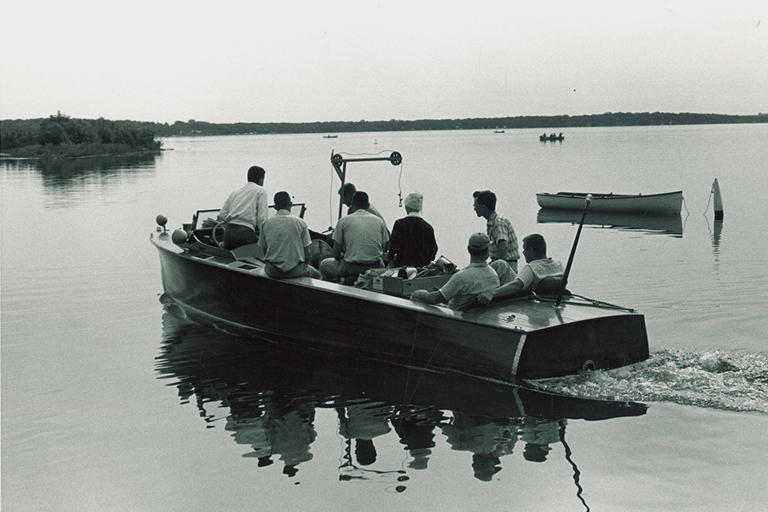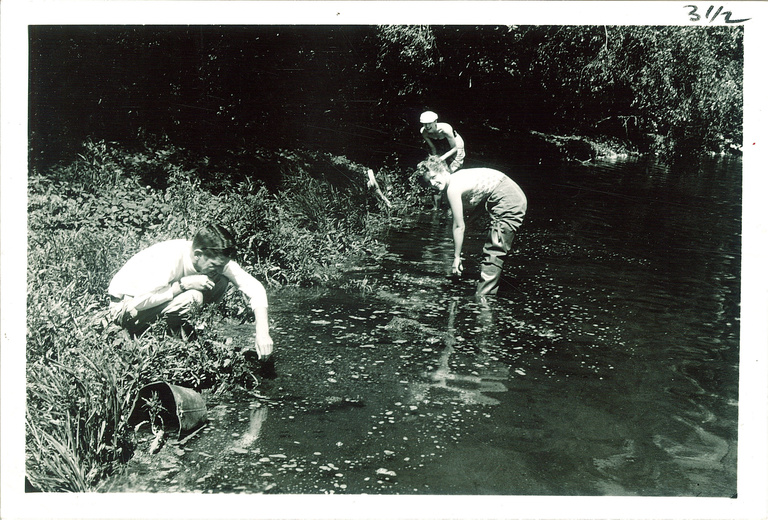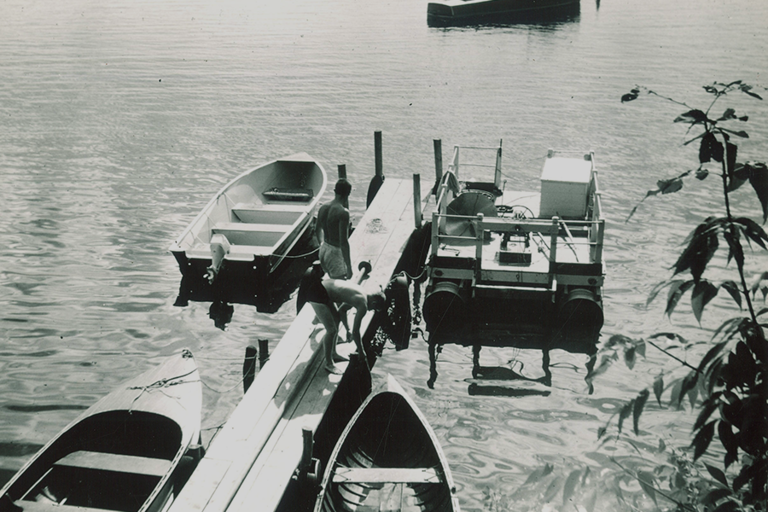
Breadcrumb
- Home
- Timeline
Historical Timeline
Mapping Our Past
Geography courses were first taught at the University of Iowa the year classes began, in 1855. Despite this, the Geography department was not established until nearly a century later, in the spring of 1946. Below is a timeline of important events throughout the department's storied history, composed with the help of James Lindberg's 2006 book, History of the Department of Geography, which details the story of how the department came to be and how it has grown since its inception.
1855
With classes just beginning, the University of Iowa offered its first geography courses in the Normal Department and the Preparatory Department. The 1856-57 catalog includes courses such as Outline of Physical Geography, Geography and Map Drawing, and Geography and the History of the U.S.
1900s
In 1909, the Lakeside Lab in Okoboji was founded by Dr. Thomas Macbride and his colleagues from the University of Iowa for the purpose of conducting environmental and natural studies. Today, the Lakeside Lab is owned by the state of Iowa and operated through the Board of Regents. Later in its history, the Lakeside Lab would be the site of several off-campus workshops and academic endeavors pursued by students and faculty in Geography and Sustainability Sciences.
1910s
Geography and geographic methods were employed by the University of Iowa Department of Military Science during the First World War. Cadets were trained in cartography and land surveying and practiced on the Pentacrest—something that is still done by some of today's Geography students learning to use surveyors' tools.
1919
Following the reorganization of the social sciences at the University of Iowa, the School of Commerce was established, and incorporated Geography courses into its offerings beginning in 1919.
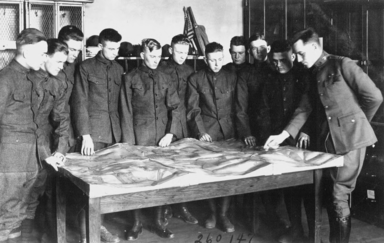
The College of Commerce offered a two-course geography sequence for freshman with "Commercial Geography" in the fall and "Economic History of the United States" in the spring.
1920s
In addition to the College of Commerce, geography courses were offered through the Department of Geology during summer sessions, though not during the regular academic year. In the early 1920s, the Summer Schedule of Courses identified the Department as "Geology and Geography" and offered classes such as Introduction to Geography, Geography of Commercial Products, Influence of Geography on American History, and Geography of North America. This combination of the departments, as posited by James Lindberg, served the needs of the teachers. The typical pattern was to offer two or three Geography courses with a faculty member from another university engaged during the summer to instruct them them. This arrangement, which began in the summer of 1922, continued until the summer of 1931.
The transient nature of geography courses was not at all unique to the University of Iowa; the presence of Geography departments in universities across the country were fairly scattered. The first geography department in the U.S. was not established until 1898 at University of California Berkeley, much later than other liberal arts and sciences programs.
1930s
Harold McCarty, in the spring of 1929 and continuing on into the 1930s, began teaching Geography courses.
During the fall semesters of 1930 and 1931, he taught Economic Resources and Industrial Geography of the U.S. He continued teaching sections of a course called Commercial, joined by C. Woody Thompson—who later would become Director of the Bureau of Business and Economics Research.
In the summer of 1932, McCarty taught Economic Geography and, in subsequent semesters or summer sessions, courses such as Industrial Geography of South America, Economic Geography of the Mississippi Basin, and Human Geography were added to the offerings. McCarty was joined by Wendall Smith, a marketing professor, in the teaching of Commercial Geography. The close association between Geography and Marketing would persist for many years to come.
In 1938, the radio station, WSUI, began broadcasting select University of Iowa courses for listeners. Registrants received regular university credit upon the fulfilling the requirements.
"Geography in the News: How did geography figure in the making of the week's news? Prof. Harold McCarty and the College of Commerce will survey the scenes on the news front, geographically speaking, in his weekly program this afternoon at 3 o'clock." - The Daily Iowan, March 10, 1938.
Alongside other such professors as Harrison John Thornton, Philip Greeley Clapp, Dorrance Stinchfield White, Ralph Henry Ojemann, and Frederick John Lazell, Professor Harold McCarty's "Economic History of the United States" was among the courses offered. McCarty also broadcasted weekly segments for his "Geography in the News" program.
1940s
Quickly becoming a non-degree sub-program, featured in the 1940-1941 University Catalog, Geography was listed within the College of Commerce. Additionally, the other sub-sections of Commerce were Accounting, Banking & Finance, Statistics, Marketing, Business Law & Labor, and Management.
As of 1946, Geography had become a recognized department.
In the year following World War II, there was a critical shortage of buildings and classroom space. Being that it was a new department, Geography and several other departments were forced to occupy temporary facilities on campus. Between 1947 and 1949, Geography classes were held in one of the temporary buildings located along Iowa Avenue, west of Madison Street. In the summer of 1948, a small number of courses were also taught at temporary buildings on Clinton Street. Starting in the fall of 1949, Geography courses moved to one of the Union Temporary Buildings north of the IMU, where Iowa Advanced Technology Lab is located today.
1950s
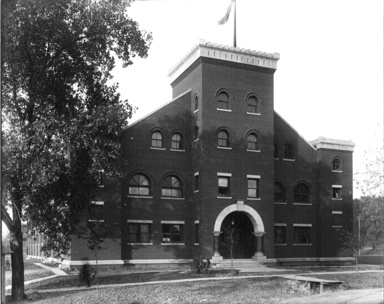
In the fall of 1952, the Geography department moved into the Old Armory, which was located where Becker Communications Studies Building now stands, on the east side of the Iowa River.
In the 1955-56 academic year, 1,025 undergraduates were enrolled in Geography courses. At the same time, total University enrollment had risen from 8,487 in the fall of 1946 to 11,822 in 1951. Despite this sharp increase in departmental enrollment, the number of full-time Geography faculty never exceeded five instructors and there was a notably high turnover rate.
It was in 1954 that the Regional Science Association was founded by Walter Izard at the University of Pennsylvania—a collective that brought together like-minded economists, planners, and geographers who had a vested interest in applying the principles and theories of economics to empirical problems in the space economy. Meetings of the Regional Science Association were widely attended by many members of department faculty and, in 1956, Izard's Location and Space Economy nearly became required reading for its graduate students. Harold McCarty, who had been a friend of Izard for years, shared many of his academic interests, later serving as Vice President of the Regional Science Association in 1962.
1960s
In the early 1960s, the Geography department began to assess its instructional programs, looking both at the undergraduate course offerings and the graduate program. The resulting unified program was presented to the Geography profession at the 1962 meetings of the West Lakes Division of the American Association of Geographers (AAG). The program consisted of courses at three levels: entry level for undergraduates, intermediate level for advanced undergraduates and beginning graduate students, and the advanced level reserved for graduate students. Courses at these three levels were available in each of the subject areas offered by the department.
Throughout this decade, Introduction to Geography lectures were recorded for showing on closed-circuit television to aid with the accessibility of the course, due to the high number students enrolled. Prior to this solution, Professor Rumage, who was giving back-to-back lectures on the subject twice each week, had been holding his lectures in Old Armory Studio Theatre to accommodate the size. The solution was to record these lectures for presentation on televisions in classrooms for discussion sections. Three classrooms in Old Armory were equipped with televisions and the format allowed for teaching assistants to show a lecture for thirty minutes and permit their sections to discuss them for the remaining twenty. Professor Rumage would occasionally visit these classes, in James Lindberg's words, "to show that he was a real life teacher" as well as watch the lectures to review them.
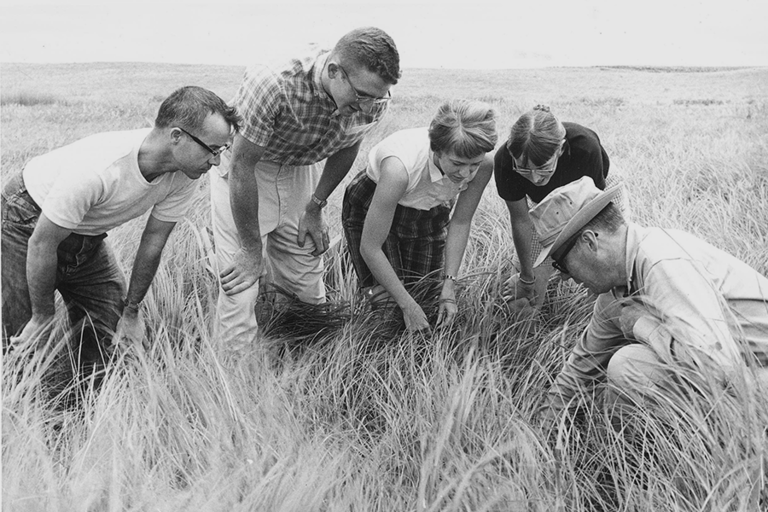
In 1960, radical geographer William W. Bunge was hired as a visiting assistant professor and James Lindberg was hired as an instructor, both of them having presented work which suited the department's interests in geographic scholarship. Bunge’s 1962 book, Theoretical Geography, published by the Royal University of Lund in Sweden, was based on his dissertation. A staunch leftist and anti-war activist, Bunge later went on to teach at Wayne State University in Detroit, then moved to Canada and taught at the University of Western Ontario and York University. Lindberg’s paper, a multiple regression and correlation study of rural farm population density in the Great Plains, was published in the Annals of the AAG and written with the help of Arthur Robinson and Leonard Brinkman.
In 1961, the geographer John C. Weaver came to the University as Graduate Dean. He had been on the faculty at the University of Minnesota, specializing in agricultural geography, and had been an administrator at the University of Nebraska just before his arrival to Iowa.
In 1963, Ronald Boyce joined the faculty to teach Urban Geography. Boyce was instrumental in developing the proposal and bringing into existence the Master’s Degree Program in Urban and Regional Planning in 1964. Over the years since, the Urban and Regional Planning Program and the Geography department have had close ties, with such joint faculty appointments as Ken Dueker, John Fuller, and Andy Isserman, students from both departments taking courses in the other, and joint research projects—especially after the creation of the Institute of Urban and Regional Research in the late 1960s, of which Frank Horton, a faculty member in the Geography department who was hired in 1966, served as the first Director.
In 1964, the American Council of Education (ACE) released its study of the quality of graduate faculty and the effectiveness of doctoral programs in each of the major fields. The University of Iowa Geography Department ranked 13th in the quality of faculty and strong in the effectiveness of the program, with only twelve departments ranked higher; all of these having more in faculty numbers than Iowa. On the campus, only two departments, Pharmacology and Political Science, were rated as highly in their fields.
The mid to late 1960s saw a period of growth throughout the department. Total students enrolled in Geography courses, which had surpassed 1,000 undergraduates by 1956, now numbered 2,000 between 1966 and 1967.
1970s
The department introduced its sub-field in Environmental Studies, for which the course offerings quickly became popular among undergraduates.
In the spring of 1970, after the tragic Kent State massacre in Ohio, student protests against the war in Vietnam on the University of Iowa campus—and college campuses across the country—erupted in solidarity with Kent State. A temporary building which stood beside the Old Armory, where the Geography department had been located since 1952, was burned to the ground during the student protests. At the time of incident, a member of the Geography faculty had managed to report the fire next door, though not in time to save the building. The department later lobbied for more spacious accommodations and was offered the fifth floor of Philips Hall, which was, at this point, newly-constructed but, knowing the College of Business would soon occupy the entirety of Philips Hall prior to the construction of Pappajohn Business Building, they declined the offer.
Mae Brodbeck, who was a student of logical positivist and Vienna Circle member Gustav Bergman, returned to the University of Iowa in the 1970s to serve as Vice President for Academic Affairs. During her time here as Vice President, she gave at least one lecture for the Friday afternoon staff seminar in Geography.
In the late 1970s, the Iowa Geography Students Association was formed. It still exists today as the Undergraduate Geography Association (UGA) and has been proactive in the organization of social events, electing representatives to faculty meetings, and sponsoring many other activities that enrich the Geography department as a community.
The opening line of Professor Harold McCarty’s “The Cornbelt Connection” article, which had been written for the 75th anniversary of the AAG in 1979, stated that “Geography came late to the University of Iowa.”
1980s
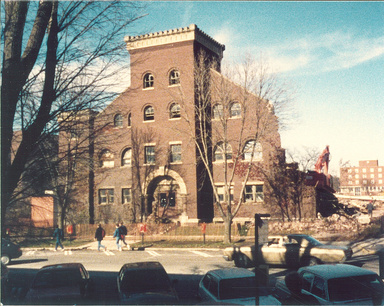
In the early 1980s, the department of Geography was able to move into the second and third floors of Jessup Hall after the International Affairs Office, among other departments, were moved to suitable locations elsewhere on campus. The burden of moving to Jessup Hall was shouldered during the 1984-85 academic year and bestowed the Geography department with a sufficient number of offices on the third floor for faculty, as well as administrative offices, two small research spaces for computer labs, and a sizeable lounge space. Offices for graduate students were located on the second floor with four classrooms and a space that is now the Geographic Information Science (GIS) Lab. Lecture classes with high numbers of students enrolled still had to be held in other locations, such as Shambaugh and Phillips Hall auditoriums. Briefly, the department also utilized part of Halsey Gym as lab space for physical geography research.
Throughout the decade, the department introduced more structure into the M.A. program by identifying five sub-programs: Locational Analysis, Political Geography, Regional Development, Transportation Systems Analysis, and Water Resources. Each sub-program had a list of required and optional courses, both departmental and cognate. This sub-program structure would later be dropped in the 1990s.
The number of undergraduates majoring in Geography was on the rise and so, too, was the number of women. A decade earlier, 1 out of 14 undergraduate majors were women. In the 1980s, and throughout the 1990s, women composed between roughly thirty to forty percent of the undergraduates majoring in Geography or its sub-fields.
Overall, the department now awarded between 10 and 20 Bachelor's degrees each year, where it had previously awarded between 1 and 5.
1990s
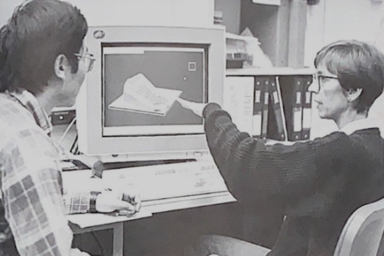
During the 1990s, the University of Iowa Department of Geography, with 11 or 12 members of faculty and more than 100 undergraduate majors, had more majors per full-time faculty than any other geography department in the Committee on Institutional Cooperation (now called the Big Ten Academic Alliance). Pennsylvania State and the University of Minnesota were Iowa's closest rivals in this statistic.
In 1991, the number of degrees awarded by the department reached 24.
It was at this time that the Geography department began to teach its own computer methods courses and listed a GIS emphasis among the sub-fields. By the early 1990s, there were roughly 86 undergraduates in the Environmental Studies track, 17 in the Urban and Regional Planning track, and 4 in the International Development track. It would not be until 2000 that the GIS specialty track was added. In the late 1990s, the Urban & Regional and International Development tracks were combined into a Geography and Social Change track.
A course titled Maps and Map Interpretation was on the list of required courses for the major as early as the 1940s and continued through the 1960s but was dropped in the 1970s, due partially to the fact there had never been a faculty member to teach Cartography. It was, however, reinstituted in the 1990s and, for a time in the later half of the decade, was required of all majors.
2000s
The first-ever GIS Day was held on November 19, 1999, during Geography Awareness Week between the 14th and 20th of November of the same year. The department has celebrated both GIS Day and Geography Awareness Week each year since.
In 2000, 16 undergraduate majors were studying in the newly-created GIS specialty track and 19 were in the up-and-coming Geography and Social change track.
In 2001, Gerard Rushton was a named a Collegiate Fellow and, in 2005, so was Marc Armstrong.
In 2006, the department celebrated its 60th anniversary with the release of professor emeritus James Lindberg's History of the Department of Geography, a book chronicling the department's past.
2010 - present
In October of 2010, the department mourned the loss of Professor Rex Honey, who had been a professor of Geography with the University of Iowa since 1974. Honey was known internationally for his contributions to political geography and the geography of human rights.
In 2013, the Environmental Policy and Planning major for undergraduates was established and remains a prominent part of UI Geography, as well as one of its most sought-after areas of study.
As students did in the earliest days of Geography at Iowa, practicing with surveyors' equipment on the Pentacrest is something students still do to this day.
Courses offered by the Geography department are now held in Schaeffer, Trowbridge, and Jessup Halls. Lectures which necessitate auditorium seating are held in many different locations on the east side of campus.
